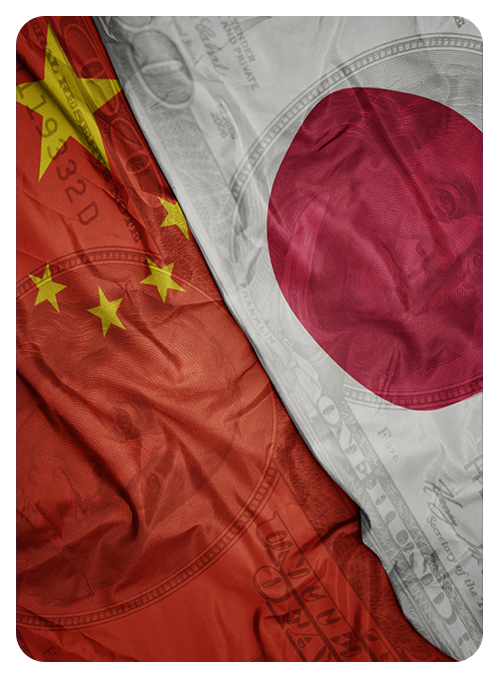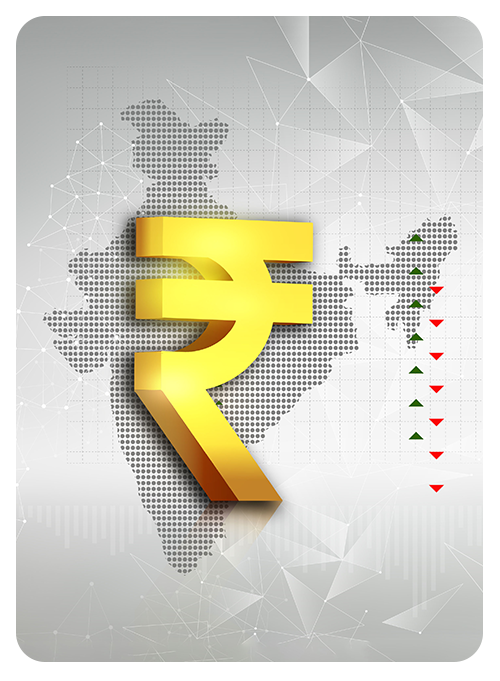Finsphere
Nifty falls for the fifth month straight:
Opens Doors for Long-Term Investors to Accumulate

Dear Clients and Stakeholders,
Indian equity market had a rough ride over the past month, on back of weak corporate earnings, uncertain environment on global trade balance and looming threats of reciprocal tariffs on Indian imports by America. Nifty went into its fifth consecutive monthly decline, the longest losing streak since 1996. February saw Nifty correct by 5.9% resulting in a 15.6% decline from the all-time highs recorded in September 2024. However, current correction presents long-term investor an excellent window of opportunity to pick quality stocks at attractive valuations.
Storm clouds have gathered over global trade after the US announced sweeping tariffs on imports into the country. The US announced that from 4th March 2025, imports from Mexico and Canada would face levies of 25% (except for import of power from Canada which would attract a 10% levy) while the tariffs on Chinese imports were raised to 20% from the earlier announced 10%. China and Canada retaliated swiftly by slapping their own set of tariffs while Mexico announced it will respond with its own tariffs against US, escalating tensions which could potentially send the world’s economy into a tailspin. Beyond tariffs, the US’s unilateral decision to withdraw support for Ukraine drew the ire of EU leaders which adds a further layer to the escalating geopolitical tensions.
The US markets were rattled by the rising threat of inflation and the effects of counter tariffs leading to S&P 500 declining 1.4% in February, reaching 5,954.50, while the tech heavy Nasdaq tumbled 2.76% to 20,884.41. The Dow Jones Industrial Average decline 1.58%, closing at 43,840.91, and broader markets reflected similar downtrend, with the Russell 2000 declining 5.5% to 2,163.07.
The IMF in its World Economic Outlook update for January 2025 reiterated its global growth forecast at 3.2% for 2024 with a projected 3.3% growth in both 2025 and 2026, though it cautioned about potential downside risks from geopolitical tensions and trade conflicts. The escalating trade conflicts between US and China, Mexico, and Canada and the resulting inflationary risks, presents an evolving economic landscape with both challenges and opportunities. Investors must remain agile, adapting to both opportunities and risks presented by this evolving landscape.
United States
Tariff and inflation are the watch words!
The annual inflation rate (CPI) in the US edged up to 3% year-on-year in January 2025, compared to 2.9% in December 2024 and factory gate prices (PPI) rose 0.4% month-on-month in January 2025, above forecasts of 0.3% led by food and energy prices.
However, the core Personal Consumption Expenditure (PCE), the Federal Reserve's preferred gauge of underlying inflation, rose by 2.6% year-on-year in January 2025, easing from 2.9% in December 2024 and in line with expectations. While the uptick in inflation rate and factory prices suggests cost pressures, the easing of PCE suggests gradual cooling in underlying inflation. This divergence between inflation rate and PCE could suggest a shift in consumer spending preferences.
The labour market remained strong as unemployment rate dipped by 0.1 percentage point to 4.0% in January 2025, the lowest level since May. Industrial production in the United States increased by 0.5% month-on-month in January 2025, helped by a rebound in aircraft manufacturing. However, retail sales saw their sharpest monthly drop since March 2023, down 0.9%, as severe weather and wildfires in Los Angeles weighed on consumer spending.

The housing market remained soft in January as consistently high mortgage rates and increasing house prices affected activity in the housing market. Monthly declines were witnessed across all major indicators, with new home sales declining by 10.5%, existing home sales declining by 4.9%, pending home sales declining by 4.6% and housing starts slumped by 9.8%. Given, aforesaid factors playing out analysts are now fearing stagflation scenario in US soon.

Eurozone & UK
Navigating a shifting policy landscape.
The much-anticipated election of EU’s largest economy, Germany, held on the 23rd of February, provided no clear majority in, leaving political parties scrambling to form a coalition. The new Chancellor and federal ministers are expected to be appointed between late April and June. Meanwhile the suspension of US military aid to Ukraine, spurred EU to announce the launch of USD 840 billion (~Rs. 73 lakh crores) defence investment to shore up the continent's collective defense by significantly boosting military spending.
The annual inflation rate in the Euro Area accelerated for the fourth straight month to 2.5% in January 2025, the highest rate since July 2024, primarily driven by higher energy costs. The core inflation, generally considered to be a better measure of sticky inflation, remained unchanged at 2.7% for the fifth consecutive month, marking its lowest level since early 2022. However, hopes of disinflation remained subdued as producer prices increased for the third consecutive month with a 0.4% month-on-month increase in December 2024.
In the UK, unemployment rate continued to remain elevated for Q4CY24 at 4.4%, however it defied expectations of 4.5% rise. Industrial production in the UK rose by 0.5% month-on-month in December 2024, rebounding from a 0.5% fall in the previous month, driven by mining and manufacturing.
Looking forward, Euro Area is set to enter a pivotal period of collective military rearmament, which could reshape fiscal policies across member nations. With an ongoing global trade war and weak demand conditions, economic uncertainty remains high.
Asia
China and Japan continue to be bright spots.
Asia remained a mixed bag with China and Japan continue to be bright spots. Japan's economy expanded at an annualised 2.8% in Q4FY24, much higher than forecasted 1% increase. Inflation rose to 4% in January, the highest since January 2023 while core inflation hit a 19-month high of 3.2%. Retail sales continued its strong run, growing 3.9% year-on-year in January, marking 34 straight months of expansion. However, industrial production remained under pressure, declining 0.2% month-over-month in December 2024.
In China, the official monetary policy tone was altered at December's Central Economic Work Conference to “moderately loose” from “prudent” for the first time since 2010. This was validated at the annual meeting of China’s top legislature, the National People’s Congress as it considered the recommendation of the Government work report to issue 1.3 trillion yuan of ultra-long special treasury bonds, much higher than the 1 trillion yuan announced last year. China also set a GDP growth target of around 5 per cent for CY25 as it grapples with a trade war with the US. February month witnessed investors shrug the threat of tariffs as excitement over Deepseek, a homegrown AI model sparked a reassessment of Chinese tech companies. The hopes of potential stimulus and the tech enthusiasm resulted in the Hang Seng index, generally considered a proxy for Chinese companies to rally 13.4% in February. Meanwhile, the People’s Bank of China left benchmark lending rates unchanged at the monthly fixing. The one-year loan prime rate (LPR) was kept at 3.10%, while the five-year LPR was unchanged at 3.60%.


India’s Economic Pulse:
India’s Growth Recovers to 6.2% in Q3FY25, But Momentum Remains Soft.
India’s GDP grew 6.2% in Q3FY25, after slowing down to 5.6% in the previous quarter. While still one of the fastest-growing economies globally, India’s growth momentum has softened due to high base effect, tight monetary policy, and constrained liquidity. RBI has lowered its Gross Domestic Production (GDP) projection for FY25 to 6.4 per cent from the earlier stated 6.6% and stated its GDP expectations for FY26 at 6.7%. Inflation has cooled significantly, falling to 4.31% in January 2025, the lowest level since August 2024, bringing it close to the RBI target of 4%. This has further strengthened the case for continued rate cuts and liquidity support for banks. Meanwhile, Industrial production grew 3.2% year-on-year in December, slowing from 5% in November. Core industries posted a fifth straight month of growth, with output expanding 4.6% in January, up from 4% in December.
The global economic landscape is evolving rapidly, with geopolitical risks, trade tensions, and inflationary pressures shaping market sentiment. The IMFs latest projections keep global growth at 3.2% for 2024, with a slight uptick to 3.3% in 2025 and 2026. However, these forecasts are subject to increasing downside risks due to the rapidly evolving geopolitical scenario.
Conclusion
At Chola Securities, we remain committed to navigating these complexities with clarity and precision, ensuring that your investments are aligned with emerging opportunities and resilient to potential headwinds.
We sincerely thank you—our valued clients and investors—for your continued confidence and partnership. Together, we look forward to embracing the challenges and opportunities of the months ahead, ensuring sustained growth and success.
Warm Regards,
Mr. Senthilkumar Naidu
Chief Business Officer, CSec
